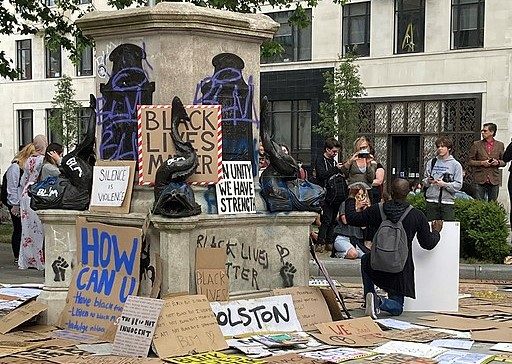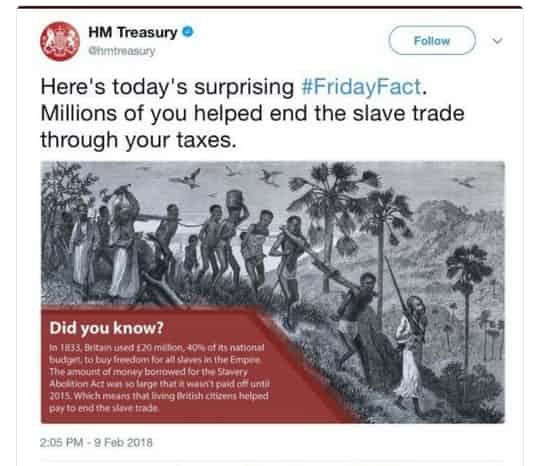
Naomi Fowler ■ Britain’s Slave Owner Compensation Loan, reparations and tax havenry

Update: you can hear Naomi Fowler and John Christensen discussing this research in edition 102 of the Taxcast, our monthly podcast, starting about 2 minutes in:
It’s hard to believe but it was only in 2015 that, according to the Treasury, British taxpayers finished ‘paying off’ the debt which the British government incurred in order to compensate British slave owners in 1835 because of the abolition of slavery. Abolition meant their profiteering from human misery would (gradually) come to an end. Not a penny was paid to those who were enslaved and brutalised.
The British government borrowed £20 million to compensate slave owners, which amounted to a massive 40 percent of the Treasury’s annual income or about 5 percent of British GDP. The loan was one of the largest in history.
We wanted to find out which financial institutions were involved in this loan, so I sent two Freedom of Information requests to the UK Treasury and the Bank of England about it. I received two responses, which I’ll detail later, but the names and details of those creditors and investors remain frustratingly out of sight. If you feel you have the skills and time to help us continue the search, please get in touch.
As the toppling of the statue celebrating slave trader Edward Colston by Black Lives Matter protestors in Bristol shows (after years of trying to have it removed, placed in a museum, and being ignored) it’s never been more painfully apparent that, as Kris Manjapra writes,
legacies of slavery continue to shape life for the descendants of the formerly enslaved, and for everyone who lives in Britain, whatever their origin. The legacies of slavery in Britain are not far off; they are in front of our eyes every single day.”
Kris Manjapra‘s article, along with the work of historian David Olusoga inspired this blog, our investigations, and our Freedom of Information requests on this subject.
British taxpayers would never have discovered they’d completed these loan repayments in 2015 if someone in the British Government’s Treasury Department hadn’t posted this on its official Twitter channel to its hundreds of thousands of followers:
The tweet was subsequently deleted, but not before this insult, and the secret was out, which David Olusoga writes about here. Here’s one of the responses to that Treasury tweet he includes:
So basically, my father and his children and grandchildren have been paying taxes to compensate those who enslaved our ancestors, and you want me to be proud of that fact. Are you f**king insane???”
As Olusoga writes:
“The Treasury’s tweet shows slavery is still misunderstood”.
Soooo misunderstood!
There is so much painful history to face up to, and the process is only just beginning. The University of Glasgow has shown leadership in this area by conducting a kind of ‘slavery money audit’ and announcing long-overdue ‘reparative justice’ measures:
Today we publish a report following a year long investigation into our links to historical slavery. And also launch a programme of reparative justice. Read the findings here ➡️https://t.co/LSy0PcMafc
— University of Glasgow (@UofGlasgow) September 16, 2018
A nation that doesn’t understand its own history and the roots of its wealth will struggle to understand how power, finance, politics and economies work. A nation that doesn’t understand its past can’t understand its present, and how the legacy of slavery and empire remain at the heart of British life today. Some of our families were enriched by it, and some of our families were impoverished and brutalised by it. It is alive in almost every aspect of modern British life you care to name.
Yet surveys tend to show that most British people declare themselves proud of the British empire. These young students, all with families from former British colonies, recently highlighted the urgent need to teach Britain’s history of empire in schools by hacking a daily newspaper, with 17 year old student Antonia saying:
After a lesson at school where Britain and its Empire was glorified, with my teacher stating “look how powerful we were”, it took four years for me to go and find a book which accurately articulated the impact that colonialism has had on this country.”
The slave owner’s compensation, and absence of any compensation for the enslaved remain at the heart of inequalities in Britain today. That compensation provided further enrichment opportunities to slave-owning families, some of whom remain at the top of the tree in Britain, with generations still being born into that inherited wealth.
David Olusoga details some of the big names that benefited from this compensation and remain part of the British elite, including former British Prime Minster David Cameron’s family.
Incredible research and information on the compensation paid to slave owners, as well as the big companies, art collections and institutions that can trace their existence back to slavery, is freely available on University College London’s Legacies of British Slave-Ownership project website.
Other institutions must follow Glasgow University’s slavery money audit example.
Organisations, councils and institutions have ignored years of campaigning to put slavery and colonialism into its proper context. People have tried for years to persuade councils to remove statues of slave traders and place them in museums so they can be viewed in their proper shameful context, rather than than as figures to be proud of.
Activists inspired by those who made history by toppling slave trader Edward Colston’s statue are already preparing to target other offensive celebrations of slave traders and brutal colonial enforcers across Britain. Some local councils have now ‘discovered’ the urgency of this by announcing a review of all statues, such as in London and Manchester.
A statue of 18th-century slave owner Robert Milligan has been removed from its place in London’s docklands. Statues around the world commemorating slave traders are also being removed. After years of ignoring people, are authorities finally starting to listen? Would they have listened if protestors hadn’t toppled slave trader Edward Colston from his pedestal in Bristol?
Those empty plinths should be replaced by memorials to slaves who, as Liverpool historian Laurence Westgaph has argued for years “deserve to be respectfully commemorated” and many were “not only interred without a marker, but without even their names.”
Removing statues and replacing them with memorials is crucial in this unstoppable movement.
And there’s another dimension to all this. We think there’s much to learn from the University of Glasgow’s ‘slavery money audit’ and ‘reparative justice’ measures when it comes to some of the former British colonies, like the overseas territories. They were focal points for slavery and empire. Then they were encouraged by the British government to develop their harmful finance sectors we see today, offering secrecy services and opening up a whole new era of exploitation and inequality.
And then the British government abandoned them, reaping the rewards of hot money being laundered there before arriving in London, yet with no benefit to the citizens of those island nations. It’s time for Britain to take responsibility.
Yet while British society has seemed comfortable with the idea that those who profited from slaves deserved compensation, while their slaves didn’t, ideas about reparations and compensation going the other way, to the enslaved, towards redressing these historic injustices, remain controversial. Most people can understand inheritances and fairness. They can immediately see why the inherited wealth of someone like the 26 year old 7th Duke of Westminster should be taxed, but not how historical wrongs related to slavery and colonialism that persist to this day, can, and should be addressed.
British responsibilities, British taxpayers
Chair of the CARICOM Reparations Commission, Sir Hilary Beckles points out that taxes from people in the Caribbean diaspora in the UK (many of them descendants of slaves) will have been used to repay the slave owner compensation loan. He describes it as “the greatest act of political immorality.” Some of the commission’s 10 Point Reparation Plan could be incorporated into a Plan B for rejuvenating British ‘satellite havens’, as full as any other location on the planet of brilliant people fizzing with innovative ideas and creative potential, yet starved of meaningful investment.
Rather than investing in people, as the Tax Justice Network’s John Christensen says: it’s “crucial to understand that the UK has created conditions of path dependence on these islands that makes economic transition hard to manage and finance”. He warned in 2002 that the dominance of finance in small island economies has crowded out prospects for diversification, as they’ve “become locked into their relationships with the offshore finance industry…any attempts at diversification into other sectors would be constrained by the need for wholesale re-skilling and the acquisition of new knowledge bases.’
In 2011, John wrote a paper with Mark Hampton on the need for more sustainable economic planning: Looking for Plan B: What next for island hosts of offshore finance? There’s much more work to be done in this area and the Tax Justice Network aims to support research where it can, and where it’s invited by those nations to do so.
As we have written, the history of abuse by Britain of its overseas territories and former Caribbean colonies is long and deeply painful. The tax havenry models Britain pushed them towards after the decline of the official empire means it has continued a self-interested exploitation that has yet to be rectified. The governments of those island nations aren’t entirely blameless, but Britain has worsened inequality and deprivation for the majority of people there, who are experiencing all the disadvantages of what the Tax Justice Network calls the Finance Curse.
And if the British government felt its responsibilities to slave owners lasted until the present day, or at least until 2015 when the original slave owner compensation loan was finally settled, what of its responsibilities to those who suffered enslavement and continue to suffer from its legacy?
Stepping up?
A UK Parliamentary vote on the creation of public registers of the real owners of companies by 2020 was aimed at ridding the overseas territories of dirty money attracted by the secrecy services offered there, from which the City of London then benefits in terms of ‘cleaned up’ money flows. However one might criticise the UK as a centre of filth (and we do), it introduced public registers of the real owners of companies in 2016. But, as Tax Justice Network’s CEO says in our statement here:
As we have documented at length, the UK’s financial secrecy network is the biggest in the world. While the UK itself is only moderately secretive according to our Financial Secrecy Index, this reflects the deliberate outsourcing of secrecy to the Crown Dependencies (Jersey, Guernsey and the Isle of Man) and the more numerous Overseas Territories (OTs) such as the Cayman Islands, number 3 in our most recent Financial Secrecy Index, and the British Virgin Islands at number 16.”
But as we point out on the Parliamentary vote for public registers to be implemented in the overseas territories, “Britain’s not the saviour here. This is just the first step in putting right a great wrong, and if it is not followed by financial assistance to help reorient the Overseas Territories’ economies, the wrong will be compounded once again.”
But as it’s turned out, the British government has now delayed beneficial ownership register requirements to overseas territories until 2023 ‘at the earliest’. Although globally, public registers are now emerging as an international global standard, there’s a long process ahead (we need public registers to include trusts and foundations, and enforcement needs to be taken seriously).
For now it seems the opaque nature of the finance sectors in British overseas territories is too useful to the City of London. But an alternative development path is needed that benefits all citizens and not just a tiny financial elite. And taking action to support that is the very least Britain can do, given the history.
Not only was the response from the British government inadequate in assisting its current and former colonies after the 2017 hurricane season, there are further serious problems in terms of projections that, “on its present course, by 2020, debt will remain unsustainable in 11 Caribbean small states, and there will be no change in 2030 when the UN’s Agenda for Sustainable Development will have run its course”. And what shape will the overseas territories be in as a result of the Covid-19 pandemic?
Following slavery money
Back to the revelation that it was only in 2015 that British taxpayers completed servicing the loan which the British government used to compensate slave owners in 1835.
Director of the new Centre for the Study of the Legacies of British Slave-ownership at UCL Dr Nicholas Draper described what he discovered about the loan in his book The Price of Emancipation: Slave-Ownership, Compensation and British Society at the End of Slavery. He confirmed to the Tax Justice Network that
Nathan Mayer Rothschild and his brother-in-law Moses Montefiore led a syndicate underwriting the issue of three new series of securities to raise £15 million: we don’t know how much they retained and how much they distributed or sub-underwrote. A further £5 million was paid out directly in government stock.”
He writes more on this in his book in pages 107-112.
The UK Government Treasury answered a Freedom of Information request in early 2018 regarding the loan, confirming that compensation payable under the Slavery Abolition Act 1833 was indeed paid off by taxpayers in 2015, and providing the following explanation:
The majority of Government borrowing is financed through the issuance of UK Government bonds known as gilts by the Debt Management Office (DMO) and as such, the majority of the Government’s debt is held in gilts. A gilt is a financial instrument that pays coupons (interest payments) twice per year to the holder of the gilt, up to and including the date on which the amount borrowed is finally repaid. Gilts are typically sold to large investment banks which, in turn, sell the gilts on to end-investors. These banks are known as the Gilt-Edged Market Makers and consist of 19 firms.
The Slavery Abolition Act (1835) Loan was rolled over into the Government’s gilt programme, ultimately into an undated gilt, the 4% Consolidated Loan (1957 or after). The term ‘undated’ refers to the fact that this gilt was issued with an earliest potential redemption date of 1957, but it was not compulsory for the gilt to be redeemed at this date. The 4% Consolidated Loan was redeemed on 1 February 2015, as part of the Government’s decision to modernise the gilt portfolio by redeeming all remaining undated gilts. More information about undated gilts can be found on the DMO’s website here.
Money borrowed to fund the Slavery Abolition Act (1835) was therefore fully repaid in 2015. The long gap between this money being borrowed and its repayment was due to the type of financial instrument that was used, rather than the amount of money borrowed.”
So, we know a bit about the mechanics of how the loan was managed, and that there were changes made in, or after 1957. But this raised more questions. We sent our own Freedom of Information request to the United Kingdom’s Debt Management Office. We wanted to know more about how the British government or the banks renegotiated the loan terms, and so, among other questions (which they say they don’t have information on) they’ve answered us as follows:
it is likely that the terms of the loan would have changed over time, but we cannot distinguish the evolution of this particular loan from our records. By way of background, during the nineteenth and early twentieth centuries the practice was to borrow by issuing fungible tranches of undated bonds. The outstanding balance of the undated bond would subsequently be varied by the issue of additional tranches and, in periods of debt reduction, by partial or full cancellations; in addition, some of these bonds were consolidated into other undated bonds.”
And so it looks as though the financial institutions or other investors would have been unaware of their precise nature because they were bundled up with other things as a general investment vehicle. After all, who would want to openly hawk an investment in government debt incurred by compensating slave owners?
Our other questions through this Freedom of Information request drew a blank:
1) What was the cumulative cost to the British taxpayer of servicing the loans over the entire period from 1835 to 2015 expressed in 2015 values?
2) Within the cumulative cost, how much was the principal, and how much was the interest, including a breakdown of the compounding effect of the interest? (also advising if there were any costs or charges such as penalties for delayed payments).
We then submitted two further questions in an information request to the Bank of England:
1) What were the names of the creditors and those financial institutions involved in trading these gilts or ‘fungible tranches of undated bonds’? Who held, sold or invested the gilts in question?
2) Who renegotiated this debt and what was the full process of decision-making from 1835 to 2015?
We received the following response:
Thank you for your email of 27 February in which you ask the following under the Freedom of Information Act 2000 (‘FoI Act’) in relation to ‘The Slavery Abolition Act (1835) Loan which was rolled over into the Government’s gilt programme’ and the 4% Consolidated Loan (1957 or after) government stock…
…We have searched the catalogues of all files (both open and closed) held by the Bank of England’s (the ‘Bank’s’) Archive but have been unable to locate any specific files relating to the 1835 loan.
We have found a file (known as the ‘Stock Jacket’) for the 4% Consolidated Loan (1957 or after) which contains administrative information on the set up of the stock but does not contain any references to the history of the 1835 loan. We do not appear to hold any further information relating to this stock.
The letter goes on to suggest further searches of its online archives or to make an appointment to visit the Bank’s Archive. We did that, but drew a blank.
Which ‘tainted corporations’ profited from the slave owner’s compensation loan?
What I really had my eye on is the names of financial institutions which knowingly invested in, or were involved in the Slavery Abolition Act (1835) Loan. It is possible that we might find records of the process by which it was rolled over into government gilts around 1957. A visit on our behalf to the Bank’s archive led historian Michele Christensen to some private investor institutions but there we drew a blank when they told us they couldn’t release that information to us because it was ‘private.’
I want to find out which financial institutions were involved because I’d love to be able to replicate in the UK what happened in the United States back in 2005 when, for the first time, a US American company, JP Morgan Chase, paid reparations for slavery. The case is described here:
J.P. Morgan Chase filed a disclosure statement with the city of Chicago on January 20 acknowledging that between 1831 and 1865, two of J.P. Morgan Chase’s predecessor banks – Citizens Bank and Canal Bank in Louisiana – accepted approximately 13,000 slaves as collateral for loans and ended up owning approximately 1,250 of them as a result of defaults.
The company apologized on its Web site and to employees and said it will provide $5 million over five years for full tuition for African American undergraduates from Louisiana to attend college in their home state.”
It’s worth reading in full. As reported in the same article, slavery reparations campaigner Deadria Farmer-Paellmann responded that this was a “step in the right direction for a tainted corporation,” but that “the nation’s no. 2 bank has a long way to go before it has fully paid its debt to African Americans”.
As the comprehensive evidence of ‘redlining’ shows, US financial institutions have a great deal of more recent structural racism to make amends for, too. The New York Times’ 1619 Project provides a deeply moving case study (podcast episode 5, part 1).
It’s frustrating that the information we seek on those financial institutions involved in Britain’s slave owners compensation loan may well be in an archive, but cannot be opened up to us. For now it brings this investigation to a close, even though it feels tantalisingly close. Those terrible wrongs from which some in the finance sector profited as recently as 2015 can never be put right, but apologies and a well-administered multi-million pound fund is the very least that those financial institutions can do now. If we can find them, and name them, we will.
A slavery money audit of those ‘tainted corporations’ in London’s finance sector would surely lead to pressure on them to apologise and make reparations.
And it’s very likely that those same institutions in the finance sector are now profiteering from depriving poorer nations of tax revenue, hiding the wealth of their richest citizens, and fuelling climate crisis. They, and their CEOs are increasingly likely to become to targets of direct action as the consequences impact on the world.
Quantifying exploitation, and steps forward
This is about clarity for a former colonial power which has barely begun to deal with its past. For a long time there have been attempts to minimise the brutality of slavery, to glorify and romanticise colonial rule, over-hype the role of British elites in abolishing slavery and underplay the grass roots struggles to end slavery and colonial exploitation. Those working to draw attention to Britain’s hidden histories often find themselves at the centre of a storm of controversy.
If British people don’t understand the past, they can’t understand the present. It is vital to understand how the City of London and Britain thrived from slavery, and colonialism, and how that continues to be played out today, nationally, and globally.
Quantifying that and trying to address it is critical. And there are precedents.
In the United States University of Connecticut researcher Thomas Craemer calculates the value of reparations with present day equivalence of between $5.9 trillion and $14.2 trillion. He was inspired to undertake his research based on reparations Germany agreed to pay to Jewish victims of the Nazis, an amount of over $89 billion since 2012.
Recent research by the economist Utsa Patnaik calculated how over around 200 years, the East India Company and the British Raj siphoned out at least £9.2 trillion (or $44.6 trillion; since the exchange rate was $4.8 per pound sterling during much of the colonial period). According to research by Robert Allen in 2005, real wages in India declined by 23.3% during the 350 years of British colonial rule. Contrary to what seems to be popular opinion in the UK, Britain de-developed India. I discussed immigraton as reparations in the Taxcast, the Tax Justice Network’s monthly podcast here with award winning author Suketu Mehta speaking about his new book: This Land Is Our Land: An Immigrant’s Manifesto on what he sees as the fastest way to fix global inequalities and injustices.
The purpose of this blog isn’t to debate the many ways reparations for slavery and colonialism could work, a lot of great research continues to be done in this area. My focus here is about doing what we can to expose London’s financial institutions involved in the ongoing legacy from slavery and empire so they can acknowledge their role and do something about it.
Legislative efforts are just beginning to give some teeth in these matters, but in non-binding ways.
In 2016 the United Nations’ Working Group of Experts on People of African Descent found that the US should pay people of colour reparations for a history of ‘racial terrorism.’ This group of experts, which included leading human rights lawyers from around the world highlighted the live link between present injustices and the US’s dark past.
And in March 2019, there’s been another watershed moment – again, it’s non-binding but the European Parliament has voted overwhelmingly to tackle structural racism faced by an estimated 15 million people of African descent, declassify colonial archives and consider “some form of reparations” for colonial era crimes.
Let me know if you have expertise and can help us continue our search for the names of the financial institutions that were involved in the slave owner’s compensation loan. We’ll report back to you if we have any new findings.
Meanwhile, here’s a lecture with Dr Draper on how the City of London was built from slavery.
Image: Edward Colston – empty pedestal.
Author: Caitlin Hobss https://twitter.com/Chobbs7/status/1269682491465576448/photo/1 Creative CommonsAttribution 3.0 Unported
Related articles

Let’s make Elon Musk the world’s richest man this Christmas!

2025: The year tax justice became part of the world’s problem-solving infrastructure

Bled dry: The gendered impact of tax abuse, illicit financial flows and debt in Africa
Bled Dry: How tax abuse, illicit financial flows and debt affect women and girls in Africa
9 December 2025

Taxation as Climate Reparations: Who Should Pay for the Crisis?

The myth-buster’s guide to the “millionaire exodus” scare story

Money can’t buy health, but taxes can improve healthcare
The elephant in the room of business & human rights
UN submission: Tax justice and the financing of children’s right to education
14 July 2025



Thank you for your work. A stark account of the instinct to utilise an opaque web of disguise to avoid public scrutiny and direct personal responsibility.
The points raised about knowingly restricted access to diverse skill sets in British Imperial tax havens are compelling. Likewise to know more about the way gilt edged investments play out.
Amazing article full of very useful and informative links – that I’ve only begun to follow…
A lot to absorb and take in as the ripples from this stretch far and wide, from the sweat shops where much of our clothing is made to the farmers who grow our food and who are exploited by non fair trade which in turn affects the planet as trees are ripped out to grow profitable crops. What a topsy turvy world.
On the section about monuments, there is a very moving slave memorial in the City of London, Gilt of Cain. http://antislavery.ac.uk/items/show/2001 it features a poem by Lemn Sissay and is described as a “unique collaborative combination of art, poetry, architecture, design and public space.”
Hi, I think this article is missing the point a little on the loan.
The government borrowed £20 million in 1835 as a 3% perpetual bond. This meant the government had to pay £600,000 per year on that debt. Inflation was then more-or-less zero, and public spending £50 million more-or-less, so this was around 1.2% of public spending.
In subsequent years GDP and public spending grew, by 1900 it was £144 million, for example.
The 1835 bond was not refinanced in 1957 as you write, but in 1927, to be repaid no earlier than 1957. The rate was 4%, forever.
In fact as it turns out for most of the years after 1927, 4% was a very cheap rate to borrow money, and the government would have booked an annual profit each year, since the value of the bond (which could be bought and sold) would have been decreasing since it promised to pay only 4% of the original sale price, and 4% would have been terrible in the 1970s or 1980s. This is different from the 19th century when there was no inflation at all, and taxpayers were paying real money towards the bond.
It is simply plainly completely wrong to say the debt was repaid in 2015. Just outright wrong. Rather there are two possible explanations: either the debt was repaid in 1927, or it has not been repaid at all.
1927 because that was when the government debts were consolidated and refinanced at 4%, and not at all, because the consols paid off in 2015 were only done because the government could by 2015 borrow money much more cheaply.
However it did not pay off the consols in order to have less debt. Rather it paid them off in order to borrow money more cheaply. So the original £20 million would simply have been re-borrowed more cheaply in 2015…..
The average current cost of borrowing is around 2.4%, so the £20 million borrowed in 1835 continues to cost around £0.5m per year, however we cannot really logically say whether or not it has been paid off since UK public debt never reached zero.
Yeah, I have two issues with this piece.
(1) focus on the past runs a risk of neglecting the immediate need for racial justice in the present. I don’t suppose the author or many people would disagree. To me present injustice is far more important.
(2) I believe the analysis wrt the compensation misses the mark.
The government bonds (gilts) issued to the ex-slavers (for free!) *could not be redeemed by the government* until after 1957. That is to say, they guaranteed a 4% income to the holder for over 100 years. Those are very unusual terms in our world where a (fixed term) 30-year gov’t bond is the longest term generally issued.
In effect, the gov’t has said to a slaver who received GBP1M worth of bonds, “here’s an income of GBP40,000 for the next 100+ years, guaranteed, and we have no right to buy that back from you or your heirs”.
“Changes in the terms” is a red herring. Marketability of the instruments is a red herring.
I am a descendant of African slaves. Born in the UK in the 60’s to Jamaican parents who were invited here in the 1950’s. My son was born here in the 1980’s. ALL three generations suffered overt and covert racism. And ALL three generations contributed through tax, to compensating the slave owners. I’ve been aware of this sickening act since 2016. This is not only unjust, but immoral and evil. I am demanding monies back. They will not get away with this. Please can you help. Please… please.
Thank you for sharing that. In these times where so many injustices seem to be coming out into the open at long last Black Lives Matter has reopened a petition which calls for the British government to return those illegitimately raised revenues https://www.change.org/p/refund-our-taxes-paid-to-compensate-enslavers I’d also like financial institutions to do slavery money audits urgently.
As a British tax payer since 1976, I will also have contributed to this loan. I am not black or a descendant of slaves but I think everyone who has contributed to the settlement of this loan should be compensated.
Thank you for sharing this research, it was and still is, a massive undertaking.
I would like to point out though that the statement that UK taxpayers were paying to slavers up until 2015 is not supported by the quotations you give in the body of your article.
As per your research, once the original payment to slave owners were made back in 1833-1835 they did not receive any further benefits from the government. The payment was obviously funded by gilts which were not slavery loan specific but form part of overall government borrowing pot over the years. 2015 was a date of gilts portfolio restructuring as was the 1957. There were potentially earlier restructuring as well which makes it impossible to state with any degree of certainty as to when the slavery loan has been fully repaid to the creditors.
I would be very much interested to help with further research in this matter as the main beneficiaries would be not only the slavers who received original payment in 1835 but also the original creditors. The the main problem of our society, as I see it, is that poverty breeds poverty and riches breed further riches.
Unless you can prove that the money to pay to slavers were specifically borrowed from the slavers themselves and gilts stayed in their possession until their redemption in 2015 you cannot claim that slavers benefited up until 2015.
Thanks so much for your work here… I’ve been down a rabbit hole desperately trying to find names of people, institutions, corporations ANYTHING/ONE that’s been a beneficiary of the peoples money.
While I wait for replies from (probably but hopefully not) hopeless emails I’ve sent all over the place today, asking for some more specific information.
I’ll keep an eye on your further postings.
Again, Thank you and Thank you.
Thank you for your work thus far and for this insightful and stunning post. I’m sharing as widely as I can. The trail of lenders and original recipients needs it’s own comprehensive documentary or podcast to build on David Olusoga’s BBC docs. https://www.bbc.co.uk/programmes/b063jzdw
Brilliant article, which I will quote in a blog I am writing about the decision this week to abolish the Department for International Development and therefore its focus on poverty reduction. I hope that’s OK. Please can you help me – Do you have any good estimate of the cumulative cost to the British taxpayer of servicing the loans over the entire period from 1835 to 2015 expressed in 2015 values? that would be a very helpful number to put our commitments to aid in context with.
Thanks for your comments. That was one of the questions I tried to ask in one of the Freedom of Information requests but I think this is difficult to assess without a lot more research into the restructuring of the loan at various points and the involvement of financial institutions in that process.
Have you looked at Rothschild and Freshfields family connections to the loan?
So Britain incurred one of the biggest debts in history to end slavery? And that’s a bad thing?
Yes it is because black Caribbean people are paying taxes towards it did black people ask to be slaves NO and the enslaved got nothing we deserve reparations and on top of it the government have the cheek to say institutional racism do not exist in Britain
It seems you are hitting a lot of brick walls, it’s quite easy for information to be kept from the public. I believe the majority of people in UK black & otherwise are not aware of this, I became aware only this week, It will definitely help to really publicise this, start some discourse, you need numbers behind you, again this is another kick in the teeth. It’s time action I believe if a million black people didn’t go to work for a day people would have to pay attention, the media needs to get involved but I guess it wouldn’t be in their best interest either, but we need to stand up and be accounted. If there is anything I can do to help please do not hesitate to ask
Indeed a very interesting article, but wrong in one important aspect. The biggest home for illicit untaxed money these day is not the UK or its former colonies, but is the USA. In many states it is possible to hide the ultimate ownership of assets and the financial sector there outweighs the UK’s many times over. The fight for tax justice needs to be taken onshore. It is no longer an offshore problem.
Do take a look at our Corporate Tax Haven Index and Financial Secrecy Index of nations, we reassess nations every two years
One of many points we’re making is that any money paid out should not have gone to those profiting from free forced labour, abuse, violence, murder, rape and kidnap. If there was to be money borrowed by the British government for a genuinely noble cause, then that should have been paid to the people who were enslaved.
Naomi I’ve found this documentary on YouTube about the 1835 slave masters payments.
https://m.youtube.com/watch?v=kgaJyp8ix4M
Interestingly it states all the information about the slaves dies exist and hopefully people can still access it.
46000 people owed slaves and it states the documents have all the names/monies information.
Great article and I will definitely be retweeting. saw your mention of a petition on change.org petition and I’d like to highlight another one – https://petition.parliament.uk/petitions/325237 “Pay Slavery Reparations to all Caribbean & African Descendants”
Thanks
Just watched David Olusoga’s BBC programmes on the Slave Compensation Act. Very stirring indeed.
A question: After the American Civil War and the abolition of slavery in the USA did the American Government pay compensation to slave owners? Or indeed did any other countries pay compensation on abolition?
It is the decendants of these families who should pay, not the British government.
Were the debts actually paid off or just consolidated on another scheme? For example paying off one credit card debt with another lower interest credit card. The loans on the one credit card can be argued to have been paid off but the loans are still being paid on another card. I read somewhere (source frustratingly lost) that Slavery Abolition Act loan was put in with loans for the ‘South Sea Bubble’ loan from late 18th century and with WW1 loans?
They have the Monopoly nothing has changed.
Are we not a nation of slaves?
if he does not participate in their way of life and their way of thinking, if he does not support their destruction he is a criminal or a terrorist.
The starving Man has had his rights stolen from him, if he stands there too long he is loitering, or if he picks an apple it belongs to somebody.
You have made him a slave to your altruism, I say charity is the most disgusting thing, he doesn’t want your charity he wants his share in what nature has provided.
But of course they are going to do it, I say you are no different you would do it too, it’s an easy way of living for them, we give them the power to exploit us, then we put them in the seat of power and armed them with the most destructive weapons.
People want to believe it’s just and a fair system, but that doesn’t mean it is!
It just means people are credulous and gullible.
When will reparations be paid to those living and future relatives of those innocents killed, maimed and tortured in European and American illegal wars around the world? – probably not even discussed for many decades if ever.
Institutions and people profited from slavery as they do now from these illegal and unjustified wars.
We must remember that our ancestors were not slaves but free people who were enslaved.
As a Jamaican , that lived in a post colonial Jamaica, that witnessed the poverty and deprivation of my islands social system when they had to borrow money from the World Bank and IMF to develop our infrastructure, loans that stipulated we gut our infrastructure ( if that makes any sense). I am curious, in that England is a part of those organizations and if Jamaica borrowed money and paid back loans could we have been paying off that slave master loan indirectly, post independence. The same could be said for any loan England gave to Jamaica directly post independence.